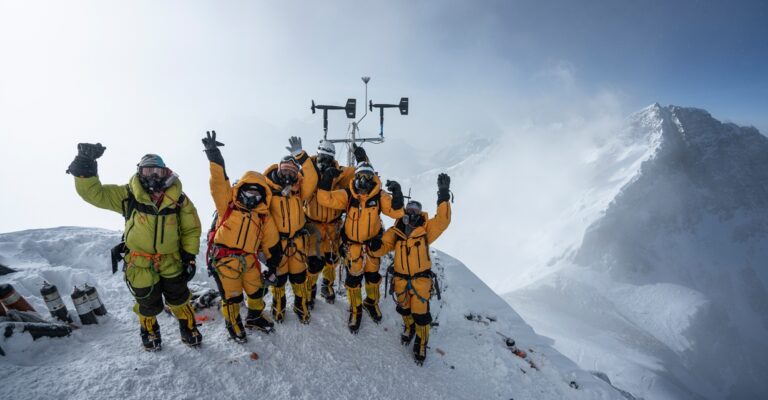
A 2019 National Geographic and Rolex Perpetual Planet Everest Expedition has earned three Guinness World Records — installing the highest-altitude weather station, collecting the highest-altitude ice core sample, and finding the highest-altitude microplastics on land.
Just after dawn on May 23, 2019, two climate scientists, Tom Matthews and Baker Perry, stood on the Southeast Ridge of Mount Everest at 27,650 feet, on the verge of making history. They had spent months preparing for this moment: the installation of the highest weather station in the world.
Their team had worked closely with a crew of engineers to meticulously construct the seven-foot-tall, 110-pound structure to withstand the extreme cold and hurricane-force winds it would face on the highest point of the planet.
They had tested it in New Hampshire and Nepal, and then had painstakingly practiced erecting it as quickly and efficiently as possible with their team of six Sherpas.
They knew that the lack of oxygen and effects of exhaustion would give them a maximum of three or four hours to get the station up and working before they had to descend. As Matthews and Perry unpacked their gear, a terrible truth began to sink in: a key piece was missing.
To lug the weather station to top of the world had required parceling its pieces out among the members of their team. And among the coils of guy-wire, aluminum poles, and various scientific instruments, there was supposed to be two short sections of metal tubing that connect the wind sensors to the main structure.
The men searched and re-searched the packs, but it was nowhere to be found. They stared at each other, both simultaneously turning over this fact in their oxygen-deprived brains and seeking a solution.
The reason any of this was worth the effort, risk, and cost is because only Mount Everest and a few of its Himalayan cousins are tall enough to reliably pierce the Sub-tropical Jet Stream—one of the narrow bands of powerful winds that circle the globe at high altitudes, influencing everything from storm tracks to agriculture growing seasons.
For climate scientists, there are few more pressing phenomena to understand than the jet stream, and the weather station would provide scientists an important new tool with which to gather data about it.
And yet there they were, on the roof of the world, with no way to attach the wind sensor—the most important part of the station.
A NEW WINDOW ON THE PLANET
Matthews and Perry had come to Everest as part of an ambitious scientific assessment of the mountain. The National Geographic Society, working in partnership with Tribhuvan University, the Government of Nepal, and funded by Rolex, launched the two-month expedition, which ultimately involved more than 30 scientists conducting fieldwork at various elevations on the mountain as well as across the rugged Khumbu Valley.
“This is a new window into the planet,” said Paul Mayewski, director of the Climate Change Institute at the University of Maine and the expedition’s scientific leader. “We believe the best way to do science on Everest isn’t just to do one kind of science, but do many kinds of science.”
The multi-disciplinary group included geologists, glaciologists, biologists, cartographers, and climate scientists, who set out to collect hundreds of water, snow, and rock samples as well as install sensors to record vegetation growth, and survey the landscape using high-resolution laser technology.
Aided by a strong support team of Sherpas, the group hoped to install weather stations and drill ice cores at both the South Col and the summit. The two weather stations (part of a network of six the team would establish on and around the mountain) would be the world’s highest.
BAD NEWS FOR THE HIMALAYA
“Climate change operates differently in different parts of the world,” Paul Mayewski said as he sat in the communications tent at base camp on the Khumbu Glacier.
“This is one of the faster warming continental regions in the world, but we don’t know what’s really going on above 5,000 meters,” he continued, “and these mountains are the water towers of the planet. Between 20-25 percent of the world’s population gets their water from the Himalaya.”
Three months earlier, in February 2019, the International Center for Integrated Mountain Development released the Hindu Kush Himalaya Assessment, a landmark report five years in the making. Collecting and analyzing data from 350 researchers and policy experts, the study forecast what is likely to happen to the Greater Himalaya, and its inhabitants over the next 80 years as the Earth continues to warm.
Even if the global community met the most ambitious carbon-reduction goals laid out by the Paris Agreement, the report warned, one-third of the region’s approximately 10,000 glaciers will be gone by the end of the century.
For the 250 million people who live across the mountain region—and the 1.6 billion people who depend on the water which flows from it—the report spelled out an enormous cataclysm that many will witness in their lifetimes.
Virtually all the glaciers in the Himalaya originate in snow deposit zones above 5,000 meters, meaning that scientists can’t put together an accurate picture of how fast the region’s glaciers are melting until they venture above 5,000 meters to understand the environment where glaciers are being formed.






